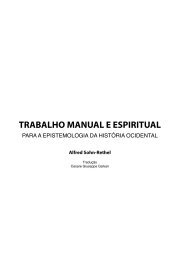Perversion the Social Relation
Perversion the Social Relation
Perversion the Social Relation
- No tags were found...
Create successful ePaper yourself
Turn your PDF publications into a flip-book with our unique Google optimized e-Paper software.
y6Octave Mannoniwithout ever intersecting <strong>the</strong> question of belief in <strong>the</strong> Katcinas or even<strong>the</strong> symbolic castration rites that are part of initiation. This is a generalphenomenon that will not surprise us any more than <strong>the</strong> fact that <strong>the</strong>fetishist does not associate his worship of <strong>the</strong> fetish with his castrationfantasies. What we have already glimpsed will be confirmed as we goalong: namely, that belief in <strong>the</strong> presence of <strong>the</strong> maternal phallus is <strong>the</strong>first belief that one disavows and <strong>the</strong> paradigm for all o<strong>the</strong>r acts of disavowal.Let us also note how difficult it would be to rewrite Talayesva'shistory in terms of repression or fantasy. The concept of <strong>the</strong> splitting of<strong>the</strong> ego does not appear to be of much service here; it is not, at any rate,indispensable, probably because we no longer conceive of <strong>the</strong> ego as asyn<strong>the</strong>tic apparatus.Talayesva's story is everybody's story, whe<strong>the</strong>r she is normal or neurotic,Hopi or not. After all, it is plain that we have installed God in<strong>the</strong> heavens, although we have found no trace of him in <strong>the</strong> sky, by dintof a transformation comparable to <strong>the</strong> one carried out by <strong>the</strong> Hopis.But, obviously, this story cannot be <strong>the</strong> same as <strong>the</strong> fetishist's; if we examine<strong>the</strong> matter more closely, we shall see that <strong>the</strong>re are major differencesamong <strong>the</strong> effects of disavowal, whe<strong>the</strong>r <strong>the</strong>y are acknowledged orignored. Because <strong>the</strong>se differences are hard to define, we shall have to tryto rough out, for better or for worse, a classificatory schema. Talayesvawould provide a good model for <strong>the</strong> simplest, most straightforward classin this schema.I have so far left aside a very important point, <strong>the</strong> fact that <strong>the</strong>realways remain non-initiated children who continue to be taken in by <strong>the</strong>imposture. A crucial feature of every initiation is that <strong>the</strong> initiated makea solemn vow to keep <strong>the</strong> secret. They will take part in perpetuating <strong>the</strong>imposture in <strong>the</strong>ir turn; one might say that <strong>the</strong> children are a kind ofprop for <strong>the</strong> adults' belief. In some societies, <strong>the</strong> women too are among<strong>the</strong> credulous; but, in all societies, beliefs are based, first and foremost,on <strong>the</strong> credulity of <strong>the</strong> children.Here I am repeating an idea that forcefully impressed itself on mewhen I asked myself, while doing o<strong>the</strong>r research, what sustained <strong>the</strong> beliefof <strong>the</strong>atergoers; 10 I wondered where <strong>the</strong> imaginary credulous spectatorwas. I will add that I do not think we have paid enough attentionto <strong>the</strong> question as to exactly what transpires when, in our societies, anadult feels <strong>the</strong> need to deceive a child — about Santa Claus, <strong>the</strong> stork,








